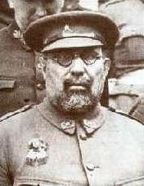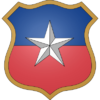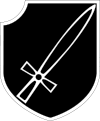Siege of San Salvador
The Siege of San Salvador (Creeperian Spanish – Creeperian: Սիտո ել Սան Սալվադոր; Creeperian Spanish – Iberic: Sito de San Salvador), also referred to as the Battle of San Salvador (Բատաժա ել Սան Սալվադոր; Batalla de San Salvador), and known in modern-Creeperopolis as The Siege (Ել Սիտո; El Sito), was the largest and deadliest confrontation of the Creeperian Civil War between the Catholic Imperial Restoration Council (Imperial Council) and the National Council for Peace and Order (National Council). The battle was fought mostly within the department of San Salvador, one of the most strategically and symbolically important regions of the country. Due to its large and complicated nature, the siege has sometimes been considered to be its own war within the Creeperian Civil War.
The siege began in May 1946 with an initial attack by the National Council against forces of the Imperial Council. The National Council's failure to win a quick and decisive victory over the Imperial Council led to a stalemate and long-lasting siege, as neither side was able to break through the other's defenses. A final offensive by the Imperial Council in August 1949 forced a National Council retreat, ending the siege in a decisive Imperial Council victory. The civil war itself would later end on 30 September 1949.
Foreign volunteers aided both the Imperial and National Councils during the conflict. In support of the Imperial Council, the nations of Castilliano and New Gandor sent divisions of soldiers to fight alongside Imperial Council soldiers. In support of the National Council, the nations of Ajakanistan and Terranihil sent divisions of soldiers to fight alongside National Council soldiers. The June 1946 Battle of Serrada is known for being fought entirely between volunteer forces: Gandorians on behalf of the Imperial Council and Terranilians on behalf of the National Council.
A total of 3.261 million people died during the siege, the vast majority of whom were civilians. An additional 4.306 million people were wounded, most of whom were also civilians, and 21.5 million civilians were displaced from their homes. Around 900,000 people were also labeled as missing (mostly civilians), with the vast majority likely having died sometime during the battle which would make the death toll over 4 million. The siege is not only the deadliest battle in Creeperian history, but also in human history.
Contents
Name
Due to the extremely complex nature of the conflict, the event has been referred to by several different names. Siege of San Salvador is the most commonly used name, however, the "San Salvador" in Siege of San Salvador refers to the department of San Salvador as a whole instead of the city of San Salvador, located in the center of the department. Other names used to refer to the military conflict include the Battle of San Salvador (not to be confused with other historical battles of San Salvador) and the San Salvador War.
The conflict's two factions also referred to the conflict by differing names. The National Council referred to the conflict as The Final Battle while the Imperial Council referred to the conflict as The Siege. Later Creeperian government officials and scholars have also referred to the conflict as The Siege due to its importance in modern Creeperian history.
Background
Failure of the Papal War
Imperial Council advances in the north
Prelude
Planning and organization
Final preparations
Order of battle
National Council order of battle
The commanders-in-chief of the National Council forces in the Siege of San Salvador were Emperors Miguel VII and Marcos I while its overall military commanders were Supreme Caudillos Juan Salinas Figueroa and Miguel Salinas Ortega. The following is the order of battle of the National Council at the start of the siege:
- North–Lake San Salvador front
Army Group Mauricio Tasis Quesada – Field Marshal José Bolívar Aguirre
- 3rd Army – General Rigoberto Fernán Tasis
- 1st Amphibious Division – Lieutenant General Pablo Zaldívar Quijada
- 3rd Infantry Division – Lieutenant General Ernesto Cruz Molina
- 3rd Motorized Division – Lieutenant General Fabián Justo Fernández
- 4th Artillery Division – Lieutenant General José Yagüe Regalado
- 6th Armored Division – Lieutenant General Adolfo Serrano Tagribe
- 10th Infantry Division – Lieutenant General Calixto Morales Guerrero
- 11th Infantry Division – Lieutenant General Damián Herrera Herrera
- 9th Army – General Ricardo Rosales Román
- 1st Artillery Division – Lieutenant General Manuel Rojo Lucho
- 4th Infantry Division (Terranilian) – Major General Adam Gát
- 7th Infantry Division – Lieutenant General Eduardo Barcía Trelles
- 9th Motorized Division – Lieutenant General Arnoldo Rodríguez García
- 10th Mechanized Division – Lieutenant General Maximiliano Ferraz Sánchez
- 13th Infantry Division – Lieutenant General José Gómez Becerra
- 20th Infantry Division – Lieutenant General Fidel Olózaga Barria
- 2nd Flotilla – Admiral Lorenzo Sarmiento Elvira
- 2nd Naval Fleet – Vice Admiral Sergio Ascaso Azaña
- 11th Naval Fleet – Vice Admiral Juan Modesto Mejía
- 25th Air Force Wing – General Antonio Morterero Nores
- East–central San Salvador front
Army Group Édgar Cazalla Beldad – Field Marshal Miguel Salinas Ortega
- 1st Army – General Alan Hurtado Ros
- 1st Infantry Division – Lieutenant General Álvaro Casanova Buenaventura
- 1st Armored Division – Lieutenant General Salvador Salinas Fraga
- 2nd Artillery Division – Lieutenant General Héctor Díaz Barrios
- 6th Infantry Division – Lieutenant General Ricardo Franco Budria
- 7th Motorized Division – Lieutenant General Roberto Saravia Casado
- 7th Mechanized Division – Lieutenant General Sergio Tuero Molina
- 8th Infantry Division – Lieutenant General Pedro Miaja Menant
- 9th Motorized Division – Lieutenant General Lucio Duarte Suñer
- 11th Army – General Rubén Alguacil Prats
- 2nd Infantry Division – Lieutenant General Joaquín Quiroga García
- 3rd Artillery Division – Lieutenant General José López Zamora
- 3rd Mechanized Division – Lieutenant General Santiago Castro Henríquez
- 4th Armored Division – Lieutenant General Gerardo Salinas Ortega
- 8th Motorized Division – Lieutenant General José Ugarte Magrina
- 17th Infantry Division – Lieutenant General Alfonso Giral Casares
- 18th Infantry Division – Lieutenant General Felipe Madrid León
- 130th Rifle Division (Ajaki) – Major General Ayushiyev Vassili
- 28th Air Force Wing – General Sebastián Pousa Frexia
- South–Volcano San Salvador front
Army Group Joel Lacasa Campos – Field Marshal Pascual Espinar Casaus
- 7th Army – General Pedro Morillo Coronil
- 2nd Mountain Division – Lieutenant General José León Rivera
- 3rd Artillery Division – Lieutenant General Víctor Guerrero Guerrero
- 3rd Cavalry Division – Lieutenant General Mateo Verón Molina
- 4th Infantry Division – Lieutenant General Carlos Obregón Nariño
- 5th Armored Division – Lieutenant General Gerardo Jalisco Castro
- 6th Motorized Division – Lieutenant General Óscar Fuentes Flores
- 13th Infantry Division – Lieutenant General Félix Gutiérrez Álvarez
- 14th Infantry Division – Lieutenant General Isaías Duarte Duarte
- 8th Army – General Antonio Yon Sosa
- 1st Mountain Division – Lieutenant General Alexander Fuentes Dávalos
- 4th Cavalry Division – Lieutenant General Hernando Enríquez Linares
- 5th Infantry Division – Lieutenant General José López Alvarado
- 6th Artillery Division – Lieutenant General Martín Bermúdez Carpio
- 1th Infantry Division – Lieutenant General Vicente Raimundo Jiménez
- 16th Motorized Division – Lieutenant General Fernando Saavedra Córdoba
- 24th Infantry Division – Lieutenant General Francisco Goyena Irujo
- 27th Air Force Wing – General Dídac Pareja Campos
- Paramilitaries (various fronts)
- National Guard – Chief Guard Ángel Moruga Leoz
- Atheist Red Army – General Secretary Mariano Alcocer Fraga
- Special Task Squadrons – General José Huerta Milano
- Elite Medical Detachment – General Carlos Madrid Figueroa
- Apostates for the Cause – General Eustacio Mena Quijada
Imperial Council order of battle
The commanders-in-chief of the Imperial Council forces in the Siege of San Salvador were Emperors Romero I and Romero II while its overall military commander was Supreme Caudillo Alfonso Cabañeras Moreno. The following is the order of battle of the Imperial Council at the start of the siege:
- North–Lake San Salvador front
Army Group King Saint Miguel I – Field Marshal Juan Primavera Sánchez
- 3rd Army – General Agustín Sarmiento Cruz
- 2nd Armored Division – Lieutenant General Vicente Gutiérrez Serrano
- 4th Mechanized Division – Lieutenant General Martín Menjívar Ulloa
- 5th Motorized Division – Lieutenant General Leonardo Parejas Obregón
- 5th Infantry Division – Lieutenant General Emmanuel Guillén Rubio
- 8th Artillery Division – Lieutenant General Alfredo Tejón Duarte
- 17th Infantry Division (Gandorian) – Major General Krystian Matulewicz
- 23rd Infantry Division – Lieutenant General Jaime Infante Morales
- 11th Army – General Héctor Carballo Lain
- 3rd Amphibious Division – Lieutenant General Fernando López Fuentes
- 9th Infantry Division – Lieutenant General Adrián Cavallería Martí
- 10th Motorized Division – Lieutenant General Osiel Suñer Melléndez
- 11th Armored Division – Lieutenant General Héctor Molina Molina
- 12th Mechanized Division – Lieutenant General Víctor Castro Ruíz
- 12th Artillery Division – Lieutenant General Daniel Mena Linares
- 29th Infantry Division – Lieutenant General Jesús Tafalla Mancebo
- Olla Volunteer Force – Brigadier Luís Larrazábal Ugueto
- 16th Flotilla – Admiral David Cortés Andino
- 16th Naval Fleet – Vice Admiral Benito Mori Díaz
- 22nd Naval Fleet – Vice Admiral Bernardo Herrera Callejas
- 3rd Air Force Wing – General Rolando Dávalos Abasto
- East–central San Salvador front
Army Group Emperor Adolfo III – Field Marshal Máximo Barrueco Morterero
- 1st Army – General Miguel Luque Mazariegos
- 1st Infantry Division – Lieutenant General Milans Bosch Ussía
- 3rd Armored Division – Lieutenant General Federico Rivas Matadeltinianos
- 3rd Motorized Division – Lieutenant General Francisco Cortéz Ureña
- 4th Artillery Division – Lieutenant General Francisco Zapata Pérez
- 7th Mechanized Division – Lieutenant General Guillermo Prieto Umaña
- 8th Infantry Division – Lieutenant General Eduardo López López
- 18th Infantry Division – Lieutenant General Juan Alcabú Obregón
- 20th Infantry Division – Lieutenant General Carlos Prats Huerta
- 2nd Army – General Álvaro Chicote Villa
- 1st Artillery Division – Lieutenant General Romero Juárez Molina
- 2nd Cavalry Division – Lieutenant General Miguel Arrondo Varela
- 2nd Infantry Division – Lieutenant General Carlos Reyes Infante
- 9th Armored Division – Lieutenant General Venustiano Zaldívar Herrera
- 9th Motorized Division – Lieutenant General José Figueroa Regalado
- 16th Infantry Division – Lieutenant General José Miralles Tamayo
- 24th Infantry Division – Lieutenant General Enrique Yagüe Moreno
- 4th Air Force Wing – General Pablo Piñón Ureña
- South–Volcano San Salvador front
Army Group King Saint Alfonso I – Field Marshal Jorge Díaz Molina
- 5th Army – General Miguel Saelices Cabal
- 1st Mountain Division – Lieutenant General Alfonso Casanova Fajardo
- 5th Artillery Division – Lieutenant General René Hernández Tassis
- 11th Artillery Division – Lieutenant General Luís Castillo Valdéz
- 13th Infantry Division – Lieutenant General Óliver Sanz Yepes
- 14th Motorized Division – Lieutenant General Antonio Flores Piñón
- 21st Infantry Division – Lieutenant General Augusto Hernández Molina
- 27th Infantry Division – Lieutenant General Javíer Castellanos Murillo
- 9th Army – General Xavier Dávalos Carita
- 1st Armored Division – Lieutenant General Tomás Cabrera Negrín
- 2nd Artillery Division – Lieutenant General Hernando Dávalos Quijada
- 3rd Mountain Division – Lieutenant General José Revelo Bermúdez
- 4th Motorized Division – Lieutenant General Carlos Infante Molina
- 9th Mechanized Division – Lieutenant General Vicente Mola Sacanell
- 17th Infantry Division – Lieutenant General José Berganza Espiga
- 22nd Infantry Division – Lieutenant General Armando Sanjurjo García
- Castillianan Expeditionary Force – Lieutenant General Maximiliér Cavaliér e Guerriér
- 7th Air Force Wing – General Aarón Tafalla Rubio
- Paramilitaries (various fronts)
- Imperial Guard – Chief Guard Gerardo Aguinaldo Villacrés
- Creeperian People's Catholic Front – General Alexander Sánchez Molina
- Militarist Nationalist Front – General Adolfo Rivera López
- Falange Creeperiano – Captain Óscar Únzaga Vega
- Camisas Negras – Caudillo Carlos Hernández Videla
Foreign military support
In the early months of the siege, various foreign volunteers and military units arrived in Creeperopolis to fight on behalf of either the Imperial or National Council in the siege. Foreign volunteers and military units were either sent by national governments or arrived on their own behalf on the basis of ideological beliefs.
The Imperial Council received support from four foreign nations: Castilliano, New Gandor, and Rakeo. The Castillianan government raised the Castillianan Expeditionary Force (FEC) which was composed of 7,500 volunteer soldiers in May 1946. As the Castillianan government was already an active belligerent in the conflict, many of its volunteers had some military experience from combat earlier in the civil war. The Gandorian government sent its 17th Infantry Division which was composed of 8,000 soldiers in August 1946. The military unit was sent in support of the Imperial Council due to ideological reasons, mainly anti-communism. The Rakeoian government sent the Olla Volunteer Force (FVO) which was composed of 9,000 soldiers; the unit was initially sent to support the Imperial Council in June 1938 and was reassigned to San Salvador in June 1946. It was mostly composed of professional soldiers, while some were volunteers, and the unit was sent on anti-communist ideological lines.
The National Council received support from two foreign nations: Ajakanistan and Terranihil. The Ajaki government sent its 130th Rifle Division which was composed of 6,000 soldiers in June 1946. The military unit was sent in support of the National Council due to ideological reasons, mainly in support of communism. The Terranilian government sent its 4th Infantry Division which was composed of 11,000 soldiers in June 1946. The military unit was sent in support of the National Council due to religious reasons, instead of ideological reasons, in opposition of Creeperian Catholicism and in support of National Atheism.
Additionally, some non-government units participated in the fighting. Despite not being organized into an organized military unit, an estimated 1,000 Senvarian mercenaries of the Senvarian Liberation Front (KSK) were hired by the National Council to fight on their behalf. The National Council and KSK had already fought together as allies against the Imperial Council during the civil war, with the National Council recognizing the independence of the Kingdom of Senvar in 1934.
Course of the siege
1946
1947
1948
1949
Propaganda
During the siege, both the Imperial and National Councils distributed propaganda to promote their own goals and vilify the goals of their opponent. The Imperial Council tended to frame the siege as an atheist and communist attack on Catholicism, the historic monarchy, and the Creeperian people, while the National Council framed the siege as a push for a final victory for liberty, equality, and the Creeperian people against fascism and theocracy.
International diplomatic positions
Diplomatic support for the Imperial Council
Diplomatic support for the National Council
Aftermath
Consequences of the remainder of the war
Casualties
Imperial Council casualties
National Council casualties
Civilian casualties
Commemoration
Monuments
In popular culture
Literature
Books
- Guerra Civil (2009) by Orlando Pareja Palau
- La'Batalla de San Salvador (1972) by Carlos López Inéz
- La'Segunda Cruzada (1995) by Francisco Bermúdez Castro
- Por'el Amor a la'Patria (2005) by Javíer Tejón Molina
Films and documentaries
Poetry
- Legal poetry:[note 1]
- La'Guerra Final del Romeristo
- La'Lucha Santo por'Dios
- La'Vida deun Romeristo
- San Salvador es Nuestro
- Siempre Lucha por la'Patria
- Illegal poetry:[note 2]
See also
Notes
- ↑ "Legal poetry" of the siege are poems written about the siege which are legal to read and are not suppressed by the Creeperian government. These poems generally were written by Romerists, however, some Miguelist seditionist and deserter poems are permitted to be viewed as they portray the National Council in a negative light.
- ↑ "Illegal poetry" of the siege are poems written about the siege which are illegal to read and are suppressed by the Creeperian government. These poems generally were written by Miguelists, however, some Romerist seditionist and deserter poems are not permitted to be viewed as they portray the Imperial Council in a negative light.
References
External links
- Battle of San Salvador (NSIndex; 20 September 2019)
- Siege of San Salvador (IIWiki; 20 January 2020)
- Articles with short description
- Use dmy dates from February 2022
- Use Jackian from February 2022
- All LCNWiki articles written in Jackian
- Pages using multiple image with auto scaled images
- Pages with broken file links
- Siege of San Salvador
- Creeperopolis
- Creeperopolis RP
- Creeperopolis Terraconserva
- Terraconserva
- Battles
- Creeperian Civil War
- Creeperian Conflicts
- New Gandor
- Terranihil
- Rakeo
- Ajakanistan



















